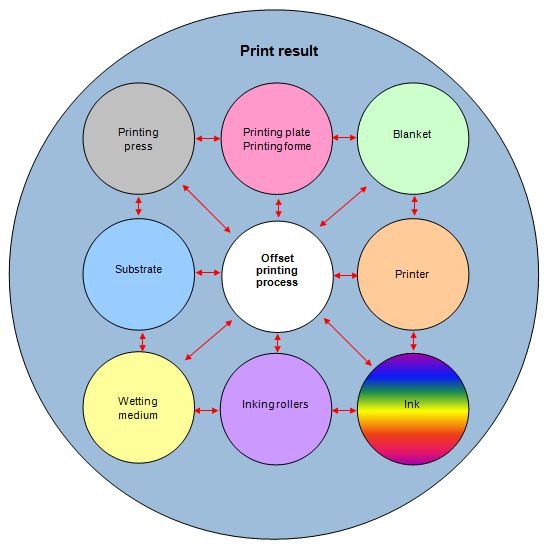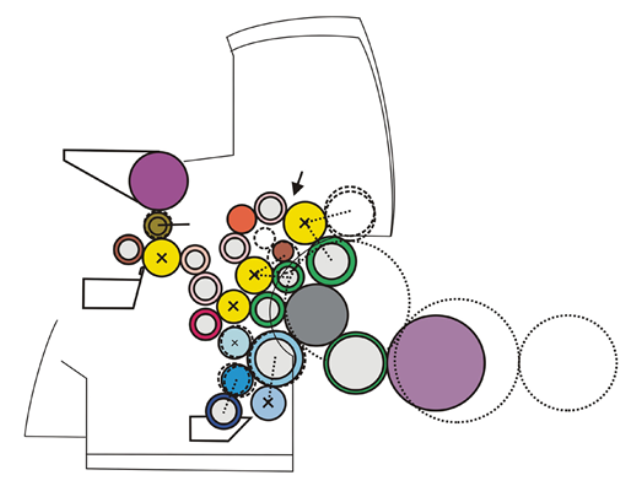03.03.2016


The factors influencing the print result of a printing process, especially in offset printing, are a frequent topic of lively discussion among printing technicians. The focus is usually on the printing press and the respective printing process, as this is where all the components required for printing come together. However, the print result also always reflects the interaction between the operating resources used, the materials, and the operating personnel. This series of articles discusses these influencing factors individually and describes them in detail.
The chart below shows the most important influencing factors, although the climate in the printing room—another influencing factor—is not discussed in detail due to significant regional differences.
Each of these influencing factors has a significant impact on the print result and is directly related to the other influencing factors. Following on from the last two issues of Gallus In Touch, which looked at the influences of the printing plate and the rubber blanket, this article will focus on rollers in the printing unit. In offset printing, this concerns the rollers in the inking unit and the dampening unit.
-2.png)
Overview of factors influencing the printing rollers:
-2.png)

In the inking unit, a distinction is mainly made between two types of rollers:
1. Steel friction rollers (yellow rollers in the ink unit diagram)
These are equipped with a color-friendly Rilsan plastic coating and also distribute the ink to the sides.
2. Rubber rollers
Rubber rollers are primarily divided into transfer rollers (red) and application rollers (green).
The lifting roller (brown) transfers the ink from the ink fountain to the inking unit. The coating thickness of the rubber rollers
is normally 6-7 mm.
The ink rollers are designed to be ink-friendly.

Rollers in the dampening unit (blue rollers in the inking unit diagram):
Various roller materials are used in the dampening unit. The dip roller (purple) and the dampening roller are coated with rubber, the metering roller (dark blue) is coated with chrome, and the remaining dampening rollers can be coated with chrome, rubber, and/or Rilsan. All dampening rollers are designed to be water-friendly.
In the ink unit:
Since only UV inks are used in label offset printing, the rubber rollers are coated with the appropriately resistant EPDM and NBR materials. Both materials have their advantages and disadvantages: EPDM materials tend to shrink, while NBR materials tend to swell. NBR materials are also less porous, but more durable.
Depending on the application, different materials can be used, e.g. for:
In the damp unit:
In the dampening unit, very dimensionally stable and cylindrical rollers are particularly suitable, as the water film must be dispensed as evenly as possible. For dampening rollers, a material that is about 10-15° Shore A softer than that used for ink rollers is used. EPDM and NBR are again used as roller materials.
Precise roller settings are essential for consistent ink and dampening water control. They should always correspond as closely as possible to the machine manufacturer's specifications and be adhered to. The settings of the dampening rollers are much more important than those of the ink rollers.
The adjustment of all application rollers to the printing plate and the friction rollers is also very important. The application rollers contribute significantly to the quality of the dampening of the printing plate and to the inking of the printing form.
The roller settings influence the following points:
Maintaining the rollers is very important for maintaining consistent print quality. The roller cleaning agents must clean the rollers thoroughly and quickly, but must not attack the roller surfaces. The roller surface must be kept smooth (non-slip), as smooth rollers are less effective at transferring ink. The rollers must not swell or shrink due to the cleaning agent, and the cleaning agent must not attack the printing plate.
The roller manufacturer or machine supplier can provide information on which detergents and care products can be used.
03.03.2016
The factors influencing the print result of a printing process, especially in offset printing, are a frequent topic of lively discussion among printing technicians. The focus is usually on the printing press and the respective printing process, as this is where all the components required for printing come together. However, the print result also always reflects the interaction between the operating resources used, the materials, and the operating personnel. This series of articles discusses these influencing factors individually and describes them in detail.
The chart below shows the most important influencing factors, although the climate in the printing room—another influencing factor—is not discussed in detail due to significant regional differences.
Each of these influencing factors has a significant impact on the print result and is directly related to the other influencing factors. Following on from the last two issues of Gallus In Touch, which looked at the influences of the printing plate and the rubber blanket, this article will focus on rollers in the printing unit. In offset printing, this concerns the rollers in the inking unit and the dampening unit.
Overview of factors influencing the printing rollers:
In the inking unit, a distinction is mainly made between two types of rollers:
1. Steel friction rollers (yellow rollers in the ink unit diagram)
These are equipped with a color-friendly Rilsan plastic coating and also distribute the ink to the sides.
2. Rubber rollers
Rubber rollers are primarily divided into transfer rollers (red) and application rollers (green).
The lifting roller (brown) transfers the ink from the ink fountain to the inking unit. The coating thickness of the rubber rollers
is normally 6-7 mm.
The ink rollers are designed to be ink-friendly.
Rollers in the dampening unit (blue rollers in the inking unit diagram):
Various roller materials are used in the dampening unit. The dip roller (purple) and the dampening roller are coated with rubber, the metering roller (dark blue) is coated with chrome, and the remaining dampening rollers can be coated with chrome, rubber, and/or Rilsan. All dampening rollers are designed to be water-friendly.
In the ink unit:
Since only UV inks are used in label offset printing, the rubber rollers are coated with the appropriately resistant EPDM and NBR materials. Both materials have their advantages and disadvantages: EPDM materials tend to shrink, while NBR materials tend to swell. NBR materials are also less porous, but more durable.
Depending on the application, different materials can be used, e.g. for:
In the damp unit:
In the dampening unit, very dimensionally stable and cylindrical rollers are particularly suitable, as the water film must be dispensed as evenly as possible. For dampening rollers, a material that is about 10-15° Shore A softer than that used for ink rollers is used. EPDM and NBR are again used as roller materials.
Precise roller settings are essential for consistent ink and dampening water control. They should always correspond as closely as possible to the machine manufacturer's specifications and be adhered to. The settings of the dampening rollers are much more important than those of the ink rollers.
The adjustment of all application rollers to the printing plate and the friction rollers is also very important. The application rollers contribute significantly to the quality of the dampening of the printing plate and to the inking of the printing form.
The roller settings influence the following points:
Maintaining the rollers is very important for maintaining consistent print quality. The roller cleaning agents must clean the rollers thoroughly and quickly, but must not attack the roller surfaces. The roller surface must be kept smooth (non-slip), as smooth rollers are less effective at transferring ink. The rollers must not swell or shrink due to the cleaning agent, and the cleaning agent must not attack the printing plate.
The roller manufacturer or machine supplier can provide information on which detergents and care products can be used.